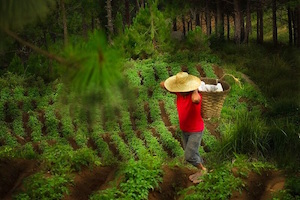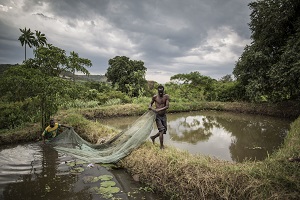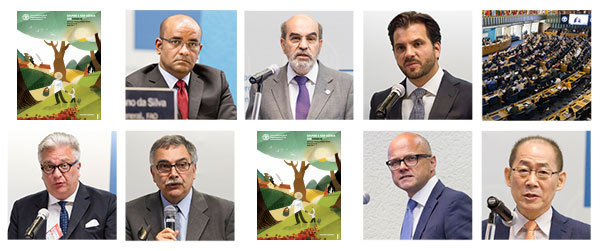Monday 18 July
5th World Forest Week and 23rd Session of Committee on Forestry opens with calls to meet the expectations of new development agenda
Watch the webcast recording of the keynote speakers delivering their statements
- H.R.H. Prince Laurent of Belgium, FAO Special Ambassador for Forests and the Environment, Prince Laurent Foundation
It is essential that we consider forests of the world as part of the answer to problems of the 21st century...
- Dr. Bharrat Jagdeo, Chairperson, 22nd and 23rd Session of the Committee on Forestry
Traditional financing mechanisms cannot deliver climate funds in the forestry sector at scale...FAO is probably the most important organization on forestry in the world and has to step up to that new role (of accessing and mediating new financing mechanisms)...
- José Graziano da Silva, Director-General, FAO: webcast opening address
It's now recognized that we can no longer look at food, livelihoods and the management of natural resources separately...Forests can help to ensure the food security of millions of people...
- H.E. Rafael Pacchiano Alamán, Secretary of Environment and Natural Resources of Mexico
The biodiversity crisis is the accelerated loss of genetic, species and ecosystems variety...
- H.E. Vidar Helgesen, Norwegian Minister for Climate and Environment
Our common challenge, then, is to demonstrate that the protection of the world's forests can go "hand-in-hand" with food security, increased welfare and green economic growth...
- Dr. Hoesung Lee, Chairman, Intergovernmental Panel on Climate Change, IPCC Secretariat
Agriculture and forestry lie at the heart of efforts to understand and tackle climate change ...
- René Castro Salazar, Assistant Director-General, FAO Forestry Department webcast opening remarks
Twenty countries have demonstrated that increasing agricultural production, feeding families and protecting forests are not mutually exclusive...
State of the World's Forests 2016 - Forests and Agriculture: Land-use Challenges and Opportunities COFO/2016/4

- Nurture Forests for the Future photo competition, REDD+ For Food ©Jaime Sumugat Singlador. Mountain Province, Philippines. Intercropping of organically grown vegetable and root crops planted in between a pine tree forest.
Forests and agriculture are central to the 2030 Agenda for Sustainable Development and have key roles in the Agenda’s overall commitments to reduce global hunger, malnutrition and poverty. The two sectors are also the focus of the 2016 edition of FAO’s flagship publication State of the World’s Forests, which sheds new light on the relationship between them.
SOFO 2016’s new data show that in recent years most of the deforestation occurred in the tropics. Specifically, while there has been a net forest loss of about seven million hectares in tropical countries, there has been a concurrent net gain in agricultural land of six million hectares, clearly indicating that deforestation is taking place to gain more land for agriculture.
But this doesn’t need to be so. SOFO’s analysis also shows that, in the past 25 years, more than 20 countries have managed to maintain or actually increase their forest cover while, at the same time, making major progress towards food security. The focus of future action should therefore foster greater synergies between the agriculture and forest sectors to reduce deforestation and improve food security, SOFO 2016 proposes.
Read more in the FAO news article and related website on the State of the World’s Forests 2016 – Forests and Agriculture: Land-use Challenges and Opportunities.
High-Level Dialogue on the SDGs

- ©FAO/Marco Longari A farmer field school land-management project established new techniques to fight erosion and land depletion. Streams of water flow out of regenerated fields, where trees and ditches allow water to penetrate into the ground and to flow downhill into ponds which are then used to farm fish. Rusumo, Tanzania.
Forestry’s contributions to the 17 Sustainable Development Goals (SDGs) and their 169 targets are wide-ranging and significant. Without them, the SDGs will not be achieved.
As countries embark on translating the world’s most ambitious development agenda into sustainable progress on the ground, forestry, aligned with the agriculture and fisheries sectors, needs to act now to instigate transformative change. The challenge is to adopt new, integrated approaches that bring about measurable and sustainable reductions in hunger, malnutrition and poverty, while conserving biodiversity and meeting the provisions of climate change agreements.
With its strong global comparative advantages, FAO is well placed to support the three agricultural sectors in increasing their multiple contributions to the successful implementation of the 2030 Agenda for Sustainable Development.
- In Peru, it's impossible to think about eradicating poverty and hunger without activities in forestry.
Fabiola Muñoz Dodero - The way we measure forestry does not show the true direct and indirect impact of sector on the broader economy.
Glenn Mason - Inadequate forest data is a big challenge in many countries for leveraging forests in national economies.
Judi Wakhungu - Farmers, foresters, pastoralists must be at the centre of any process of change.
Maria Helena Semedo - ‘Forests and food’ is a good slogan – we are connecting people, and this is at the centre of the SDGs.
Susil Premajayantha
Read more in the related COFO document COFO/2016/5.1
Investing in the Great Green Wall to ensure the sustainability of Africa's drylands

- ©FAO/Giulio Napolitano. Djibo, Burkina Faso. Tractor at work to prepare the land for the planting and sowing of seeds of woody and herbaceous fodder species.
An expression of solidarity between more than 20 African countries and a coalition of local and international partners, Africa's Great Green Wall (GGW) is a mosaic of sustainable and integrated land-management interventions, and the continent’s most ambitious attempt to reverse land degradation, desertification and food and livelihood insecurity across the Sahara and the Sahel, and to combat climate change.
The GGW puts local communities at the heart of its efforts, promoting local knowledge and capacities. This needs to be urgently matched with investments by development actors and policymakers, in order to ensure the long-term sustainability of Africa's drylands and of local people's livelihoods.
- The Great Green Wall offers hope and solidarity to the people of Africa's drylands.
José Graziano da Silva - The Great Green wall is one of the most audacious efforts in human history.
Mahamat Bachir, Minister for Environment, Water & Fisheries, Chad, on behalf of the African Union
Read more about the 18 July WFW 5 event, The Great Green Wall: Africa's response to climate change and zero hunger.
Political will and inclusiveness underpin success of integrated food security-forest rehabilitation policies
As the global consensus on the agricultural sectors shifts towards integrated land-use planning that fosters both sustainable forestry and agriculture, the successful experience of the Republic of Korea (ROK) stands out as a shining example.
One key lesson learned is the pivotal role of government and state institutions: without visionary political will and coherent consultation, planning and action involving local communities, the rehabilitation of ROK’s forests and its higher levels of food and livelihood security would not have been possible.
Read more about the WFW5 FAO-Republic of Korea 18 July side event and related FAO publication on Integrated policy for forests, food security and sustainable livelihoods: lessons from the Republic of Korea.

